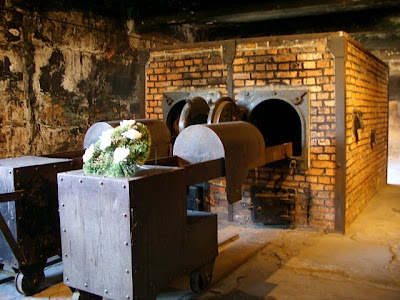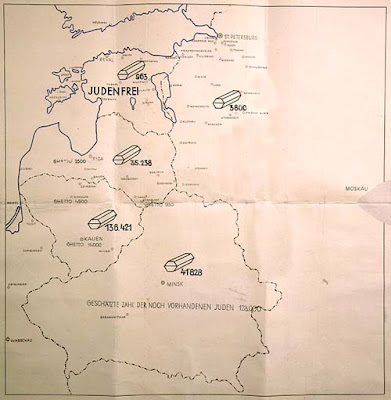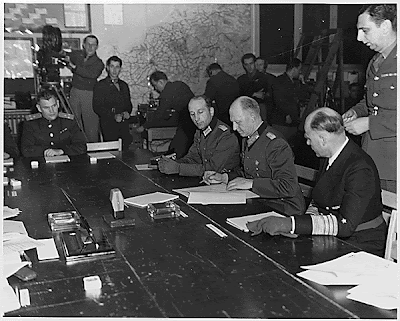
The National Socialist German Workers' Party (abbreviated NSDAP from German), commonly known in English, in short, as the Nazi Party, It was a political party in Germany between 1919 and 1945. It was known as the German Workers' Party (DAP) before the name was changed in 1920. Hitler joined the DAP in September 1919.
The party's last leader, Adolf Hitler, was appointed Chancellor of Germany by president Paul von Hindenburg in 1933. Hitler rapidly established a totalitarian regime known as the Third Reich.
Nazi ideology stressed the failure of democracy, failure of capitalism, racial purity of the German people, and persecuted those it perceived either as race enemies or those defined as "life unworthy of living". This included Jews, Slavs, and Roma along with homosexuals, the mentally disabled, communists and others. To carry out these beliefs, the party and the German state which it controlled organized the systematic murder of approximately six million Jews and five million other people from the aforementioned and other groups, in what has become known as the Holocaust.
The Nazis' strongest appeal was to the lower middle-class – farmers, public servants, teachers, small businessmen – who had suffered most from the inflation of the 1920s and who feared Bolshevism more than anything else. The small business class were receptive to Hitler's anti-Semitism, since they blamed Jewish big business for their economic problems.
The Nazi Party might never have come to power had it not been for the Great Depression and its effects on Germany. By 1930 the German economy was beset with mass unemployment and widespread business failures. The SPD and the KPD parties were bitterly divided and unable to formulate an effective solution; this gave the Nazis their opportunity, and Hitler's message, blaming the crisis on the Jewish financiers and the Bolsheviks resonated with wide sections of the electorate. At the September 1930 Reichstag elections the Nazis won 18.3% of the vote and became the second-largest party in the Reichstag after the SPD. After two more successful election campaigns, in which the Nazi party scored 37.4% and 33.1% respectively, Hitler was nominated as Chancellor on 30 January 1933.
1933–39 saw the gradual fusion of the Nazi Party and the German state, as the party arrogated more and more power to itself at the expense of professional civil servants. This led to increasing inefficiency and confusion in administration, which was compounded by Hitler’s deliberate policy of preventing any of his underlings accumulating too much power, and of dividing responsibility among a plethora of state and party bureaucracies, many of which had overlapping functions. This administrative muddle later had severe consequences. Many party officials also lapsed rapidly into corruption, taking their lead from Göring, who looted and plundered both state property and wealth appropriated from the Jews. By the mid-1930s the party as an institution was increasingly unpopular with the German public, although this did not affect the personal standing of Hitler, who maintained a powerful hold over the great majority of the German people until at least 1943.
In June 1934, Hitler, using the SS and Gestapo under Himmler's command, staged a coup against the SA (a paramilitary organization of the Nazi Party), having Röhm, its leader, and about 700 others killed.
The effect of the purge of the SA was to redirect the energies of the Nazi Party away from social issues and towards racial enemies, namely the Jews, whose civil, economic and political rights were steadily restricted, culminating in the passage of the Nuremberg Laws of September 1935, which stripped them of their citizenship and banned marriage and sexual relations between Jews and "Aryans". After a lull in anti-Semitic agitation during 1936 and 1937 (partly because of the 1936 Olympic Games), the Nazis returned to the attack in November 1938, launching the pogrom known as Kristallnacht ("Night of Broken Glass"), in which at least 100 Jews were killed and 30,000 arrested and sent to concentration camps, and thousands of Jewish homes, businesses, synagogues and community facilities were attacked and burned. This satisfied the party radicals for a while, but the regional party bosses remained a persistent lobby for more radical action against the Jews, until they were finally deported to their deaths in 1942, 1943, 1944, and most poignantly in Spring of 1945—days before Liberation.
By 1945 the Nazi Party and the Nazi state were inseparable. When the German armies surrendered to the Allies in May 1945 and the German state ceased to exist, the Nazi Party, despite its 8.5 million nominal members and its nation-wide organisational structure, also ceased to exist. And it was also clear that a Nazi Party without Hitler had no basis for existence. Its most fanatical members either killed themselves, fled Germany or were arrested. The rank-and-file burned their party cards and sought to blend back into German society. The Nazi Party was banned by the Allied occupation authorities and an extensive process of denazification was carried out to remove former Nazis from the administration, judiciary, universities, schools and press of occupied Germany. There was virtually no resistance or attempt to organize a Nazi underground. By the time normal political life resumed in western Germany in 1949, Nazism was effectively extinct. In eastern Germany, the new Communist authorities took their vengeance on any former high-ranking Nazis that they could find, and the survival of any kind of Nazi movement was out of the question.
Since 1949 there have been attempts to organise ultra-nationalist parties in Germany, but none of these parties was overtly Nazi or tried to use the symbols and slogans of the Nazi Party.
Source: Wikipedia (All text is available under the terms of the GNU Free Documentation License)















